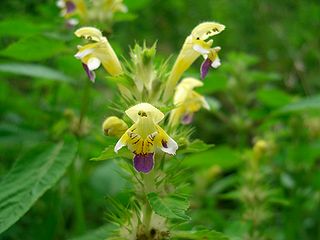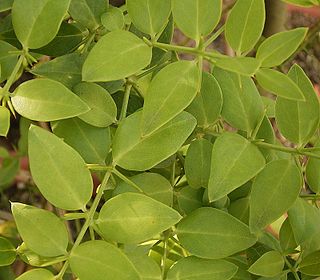
The Lamiales are an order in the asterid group of dicotyledonous flowering plants. It includes about 23,810 species, 1,059 genera, and is divided into about 24 families. Being one of the largest orders of flowering plants, Lamiales have representatives found all over the world. Well-known or economically important members of this order include lavender, lilac, olive, jasmine, the ash tree, teak, snapdragon, sesame, psyllium, garden sage, and a number of table herbs such as mint, basil, and rosemary. Lamiales and Orobanchaceae are both the largest populated parasitic angiosperms of flowering plants.
The International Treaty on Plant Genetic Resources for Food and Agriculture, is a comprehensive international agreement in harmony with the Convention on Biological Diversity, which aims at guaranteeing food security through the conservation, exchange and sustainable use of the world's plant genetic resources for food and agriculture (PGRFA), the fair and equitable benefit sharing arising from its use, as well as the recognition of farmers' rights. It was signed in 2001 in Madrid, and entered into force on 29 June 2004.

Wastewater treatment is a process used to remove contaminants from wastewater and convert it into an effluent that can be returned to the water cycle. Once returned to the water cycle, the effluent creates an acceptable impact on the environment or is reused for various purposes. The treatment process takes place in a wastewater treatment plant. There are several kinds of wastewater which are treated at the appropriate type of wastewater treatment plant. For domestic wastewater, the treatment plant is called a sewage treatment plant. For industrial wastewater, treatment either takes place in a separate industrial wastewater treatment plant, or in a sewage treatment plant. Further types of wastewater treatment plants include agricultural wastewater treatment plants and leachate treatment plants.
David Sztybel is a Canadian philosopher specializing in animal ethics.

Allium canadense, the Canada onion, Canadian garlic, wild garlic, meadow garlic and wild onion is a perennial plant native to eastern North America from Texas to Florida to New Brunswick to Montana. The species is also cultivated in other regions as an ornamental and as a garden culinary herb. The plant is also reportedly naturalized in Cuba.

Harrisia is a genus of night blooming cacti native to Argentina, Paraguay, Brazil, Bolivia, Uruguay, the Greater Antilles, the Bahamas, and the U.S. state of Florida. The genus is named after William Harris, an important botanist of Jamaica. There are about 20 species.

Acacia melanoxylon, commonly known as the Australian blackwood, is an Acacia species native in South eastern Australia. The species is also known as Blackwood, hickory, mudgerabah, Tasmanian blackwood, or blackwood acacia. The tree belongs to the Plurinerves section of Acacia and is one of the most wide ranging tree species in eastern Australia and is quite variable mostly in the size and shape of the phyllodes.

Allium validum, known by several common names including swamp onion, wild onion, Pacific onion, and Pacific mountain onion, is native to the Cascade Range, to the Sierra Nevada, the Rocky Mountains, and other high-elevation regions in California, Oregon, Washington, Nevada, Idaho and British Columbia.

Roughly one-third of Iran's total surface area is suited for farmland, but because of poor soil and lack of adequate water distribution in many areas, most of it is not under cultivation. Only 12% of the total land area is under cultivation but less than one-third of the cultivated area is irrigated; the rest is devoted to dryland farming. Some 92 percent of agricultural products depend on water. The western and northwestern portions of the country have the most fertile soils. Iran's food security index stands at around 96 percent.

Andrographis paniculata, commonly known as creat or green chiretta, is an annual herbaceous plant in the family Acanthaceae, native to India and Sri Lanka.

Qarabagh, is a district 56 km to the south-west of Ghazni in eastern Afghanistan. The 1,800 km2 area is one of the most populated at 109,000; some reports count more than 218,000. The ethnic composition of the district includes Hazaras and Pashtuns. The landscape varies in different parts of the district - deserts in the southwest, plains in the southeast and mountains in the north. The district is seriously affected by drought, especially farming and animal husbandry. Health and education need serious improvement.
A fish factory, also called a fish plant, fish processing facility, is a facility where fish processing is performed. Fish factories range in the size and range of species of fish they process. Some species of fish, such as mackerel and herring, and can be caught at sea by large pelagic trawlers and offloaded to the factory within a few days of being caught. Or the fish can be caught by freezer trawlers that freeze the fish before providing it to factories, or by factory ships which can do the processing themselves on board. Some fish factories have fishing vessels catching fish for them at a given times of the year. This is to do with quotas and seasons conflicting how much and when the fish can be landed.
Baldev Singh Dhillon is an internationally renowned agricultural scientist and had been the vice chancellor of Punjab Agricultural University from 2011 to 2021 in India.

Azima is a genus of plants in the family Salvadoraceae.

Grapevine yellows (GY) are diseases associated to phytoplasmas that occur in many grape growing areas worldwide and are of still increasing significance. Phytoplasmas are obligate cell wall-less bacterial pathogens, and rely on plants and homopterous phloem-sucking insects for biological dispersal. In plants, they are mainly restricted to the phloem tissue where they can move and multiply through the sieve tube elements. Almost identical symptoms of the GY syndrome are caused by different phytoplasmas and appear on leaves, shoots and clusters of grapevine. Typical symptoms include discoloration and necrosis of leaf veins and leaf blades, downward curling of leaves, lack or incomplete lignification of shoots, stunting and necrosis of shoots, abortion of inflorescences and shrivelling of berries. Those symptoms are related to callose deposition at the sieve plates and subsequent degeneration of the phloem. Although no resistant cultivars of Vitis vinifera or rootstocks are known so far, the various grape varieties differ considerably as far as symptom severity is concerned. It ranges from fast decline and death in highly susceptible cultivars to tolerant rootstocks as symptomless carriers of the pathogen. Currently, the only available control strategies include early eradication of infected crops, early eradication of infected source plants, and chemical control of vectors through regular insecticide treatments.

Nepheronia buquetii, the plain vagrant, Buquet's vagrant, or green-eyed monster, is a butterfly of the family Pieridae. It is found throughout Africa.
Organica Technologies is an organization that builds wastewater treatment plants that can be used in agriculture, irrigation or municipal areas using patented technology. The company’s goal is to treat, recycle, and conserve wastewater. Organica treatment plants are smaller than traditional options, and are created in greenhouses. Founded in 1998, Organica is headquartered in Budapest, Hungary, with branch offices in India, Singapore, and the United States.

Space farming refers to the cultivation of crops for food and other materials in space or on off-Earth celestial objects – equivalent to agriculture on Earth.

Friedelin is a triterpenoid chemical compound found in Azima tetracantha, Orostachys japonica, and Quercus stenophylla. Friedelin is also found in the roots of the Cannabis plant.

Hebbal Lake is a lake in the city of Mysore, India.















